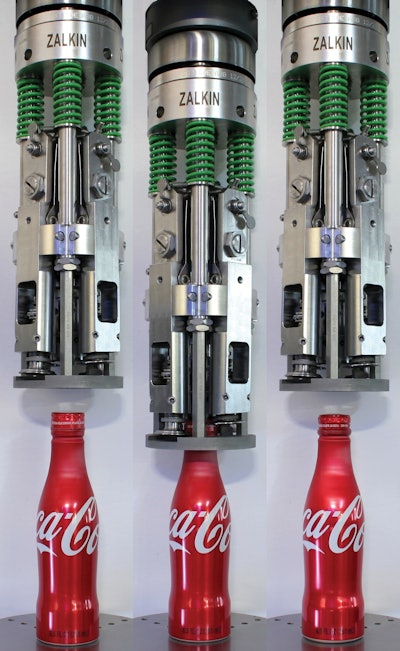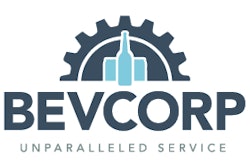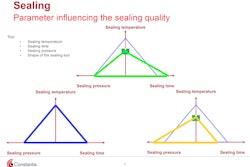Coke’s contoured glass bottle might be one of the most recognizable packages in the world. When the company introduced an aluminum bottle in 2005, it had, of course, the iconic Coca-Cola contour shape. But few people outside of Coke know how much time and energy the Atlanta-based beverage giant has spent on optimizing its aluminum bottle. Much of that effort has had to do with the cap.
It all started in 2003, says Alejandro Santamaria, Packaging Development Manager for Sparkling Brands. “We saw the aluminum bottle as an opportunity to blend the benefits of all of our mainstream packages together into a single package that would represent the ideals of the company and deliver a package that furthers the emotional connection our consumers have with Coca-Cola,” says Santamaria. “Aluminum cans are our most popular package in North America, and one of the things people love about cans is the cold feel in their hands. That feeling is inviting and refreshing. Then there is the iconic contour. Last, but not least, is the fact that aluminum bottles are 100 percent recyclable, which is important to consumers and The Coca-Cola Company.”
Since the development program began there have been three generations of the 8.5 oz. (250-mL) aluminum bottle and numerous iterations within each generation. Each generation had essentially the same contour shape. The major visible difference was the closure. Generation One, 2005-2007, featured an impact-extruded body with a pry-off crown cap. A second iteration of this was a crown cap with pull ring that was made available in Europe.
In 2008 Generation Two, still an impact-extruded aluminum bottle, featured an injection-molded PET “outsert” finish that was press fit to the aluminum neck. This injection-molded piece had the firmness and rigidity that made it possible to utilize a roll-on pilfer-proof closure, which was viewed as a big step forward because ROPP caps are easy to twist off. They also make the bottle resealable.
Gen 3
With Generation Three, introduced in 2009, Coke moved away from impact extrusion, featuring a drawn and ironed aluminum body. This is the same process used to form aluminum cans. This bottle was about 40% lighter than its impact-extruded predecessor and did not require a press-fit PET outsert. The draw and iron process increased the speed of production. But it presented unique closure challenges because without the rigid injection-molded PET outsert, the bottle’s finish no longer presented a rigid enough surface against which to roll on an aluminum cap. So in order to get this optimized bottle/closure combo into widespread distribution, there was work to be done.
The Coca-Cola Company development team identified several criteria that had to be met to achieve a successful ROPP closure application.
The capping machine would have to be “double-acting.” First it would have to push the aluminum capsule down onto the top of the bottle, creating a good seal between the EVA gasket material and the neck finish. Then the machine would have to gently roll on the cap, in the process forming the cap threads and tamper-evident band.
The capping machine’s loading control had to be precise and consistent. Too much top load and the bottle might deform, too little and there wouldn’t be a secure enough seal capable of keeping CO2 from escaping.
Achieving a specific opening torque signature was essential if consumers were to have a good experience with the new aluminum bottle.
The design team met with a number of different vendors of roll-on capping equipment. Fowler Products, a division of Pro Mach, offered a suitable double-acting capping solution provided by its manufacturing partner Zalkin.
“One of the main hurdles in aluminum to aluminum roll-on closures is that you have to deform the cap—form grooves—without deforming the neck finish,” says Andy Monroe, who was Director of Sales for Fowler during the development effort. “Zalkin had to refine the roll-on capping technology to be more gentle and gradual than is the case with glass or PET packaging. The capper had to effectively seal the bottle while not deforming the neck finish on the bottle as the cap was formed. At the same time, because this was a carbonated beverage, we still had to have a fairly substantial amount of compression on the gasket material to reform the closure to retain carbonation.”
Fowler began with The Coca Cola Company development team by manufacturing two single-head bench-top laboratory cappers with one destined for Coca-Cola’s lab in Atlanta and the other for Fowler’s in Athens, GA. This made it possible for both development teams to work simultaneously on issues of top load, secure seal, and torque. Subsequently, Zalkin in France manufactured a five-head rotary capping machine. A team member from The Coca Cola Company went to the Zalkin facility for the factory acceptance test. That machine was shipped to the U.S. and placed in The Coca-Cola Company’s Corporate Center packaging lab in Atlanta for further development work. Once the machine met key parameters such as the desired torque signature, along with favorable secure seal test results, the machine was moved to a pilot line. That pilot line started in 2009 and ran until early 2013. Over that period, production rates gradually increased and The Coca-Cola Company went on to learn what consumers thought of a package that looked like a bottle with the cold refreshing feel of a can.
Consumers dug it
“Our consumers were delighted,” Santamaria said. “This is one of those unique packages that satisfies all of the consumer’s preferences. This has been one of those projects in which management went above and beyond to support a decade of development. This effort went outside a packaging mind-set that considers only productivity and cost. Instead, management’s goal was to produce a package that could establish an emotional connection between the consumer and the brand.”
During the period from 2009 to 2013, The Coca-Cola Company measured and defined the critical factors essential for successful roll-on capping for aluminum bottles. The company must:
• Use end-to-end statistical process control and have full traceability and pre-established reaction plans
• Give special emphasis to incoming bottle quality
• Carefully control capping loads and always be precisely aware of the operational limits
• Be thorough when qualifying setup or design changes – test for worst-case scenarios.
In 2013, the aluminum bottles began rolling off a new high-speed production line in Truesdale, MO, that supplies primarily the U.S. and Canada. It features a monoblock rinser/filler from Bevcorp that has 120 filling valves followed by a 20-head Zalkin capping machine that leverages all of the R&D efforts described above. Most essential in this unique machine are the individual capping heads themselves. While conventional ROPP capping heads make one revolution around the neck finish to deform threads into the aluminum capsule, these tools make two passes around the neck finish. It’s a matter of exerting less side load pressure per revolution yet still producing a secure seal. Also unique is the way in which top load pressure is handled. Without articulating how or why this proprietary bit of technology is able to do what it does, Zalkin says that the capping heads deliver the 250 lb of force needed to produce a secure seal of EVA gasket to aluminum neck finish, yet they do it gently enough to not crush the thin-walled container.
Inspecting the effectiveness of the filling and capping operation in the Truesdale plant is a Silgan vision inspection system. Closures are supplied by Silgan White Cap and Exal Corp. makes the bottles.The line fills the 8.5-oz bottles at 800/min.
Today, the aluminum bottles are The Coca-Cola Company’s premium package. The metal bottles are made available to upscale venues and at high-profile gatherings and events such as Fashion Week in New York City. The bottles invariably have a placement in The Coca-Cola Company’s advertisements.
Santamaria says that the company is continuing to make design and manufacturing changes, including reducing the amount of aluminum consumed. Fowler and Zalkin remain involved in the overall development project.
“Our feeling is that the pioneering work of The Coca-Cola Company has made aluminum bottles with ROPP closures an option for companies looking for a new premium package for their products,” says Fowler’s Monroe.



























